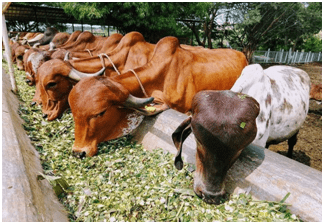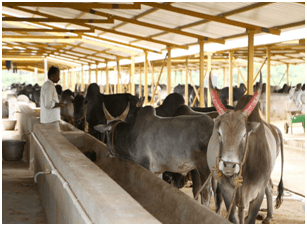Dr.Chandan Kumar Sanjana Devda and Palak Verma
RVSKVV Gwalior (M.P)
Introduction:
With the increasing commercialization of dairy farming and ever-larger herd sizes comes a corresponding increase in the number of animals which are either unwanted or otherwise surplus to requirements. Just as other industries are increasingly being expected to manage their by-products in a safe and responsible manner, there is an expectation that as part of a professional and modern industry, commercial dairy enterprises will do the same.
Commercial dairy farmers in India have both a ‘duty of care’ and a moral responsibility to ensure that all reasonable steps are taken to ensure the welfare of their animals, and this includes unwanted animals. Abandoning unwanted animals is an offence under section 11(I) of the Prevention of Cruelty to Animals Act 1960 and is also unprofessional, undermining the credibility of the entire Indian dairy industry.
One way of reducing the impact of unwanted animals on the farm business is to use animals (including crossbreeds) that are suited to the local environment, as they are more resilient to Indian conditions than overseas genetics. If purebred, high-yielding strains are used, e.g. North American Holstein animals, special care must be taken to ensure that their nutritional and welfare needs can be met when they are no longer required on the farm.
KEY POINTS
1. Unwanted animals must not be abandoned.
2. Every farm must have a plan in place for the humane management of unwanted animals.
3. Where animals are relocated to a Gaushala, an arrangement to support the on-going care of the animals must be in place between the farm and the gaushala.
4. All animals must be moved on and off the farm in accordance with the Transport of Animals (Amendment) Rules, 2001.
Achieving compliance with the Minimum Standards:
There are two main options for achieving compliance with the Minimum Standards described above. First, low producing animals or surplus calves can be sold or given to other farmers, as long as they can show they have the resources to adequately feed and care for the animals Alternatively, unwanted animals can be relocated to a gaushala. There is a risk that the gaushala will not be able to adequately care for the animals. This is especially important where high-yielding animals are concerned, as they have specific nutritional needs that cannot be met by feeding the same diet as indigenous cows. So make sure they will accept and they can be motivated because there is a lot of option to carry out different breeding program over there.
Recommended practices for management of unwanted animals:
The following are specific recommended practices for the management of particular classes of unwanted animal.
A) Low Milk Producing Animals:
Animals whose milk production has dropped well below the herd average are likely candidates for humane removal from the farm. Before removing these animals, the decline in milk production should be confirmed by reference to on-farm production records or manual milking if necessary. Health, injury and environmental factors, e.g. heat stress, should be investigated. Immediate remedial action should be taken if ill- health, injury or environmental factors are evident. This may include veterinary examination and treatment. If no improvement in milk production is evident following remedial action, the animal may be removed from the herd. If the animal is of particularly high genetic merit, consider using them as breeding stock, otherwise on- selling or relocation to a gaushala is recommended.
B) Non-Reproductive Animals:
Animals with low fertility or other reproductive complications are also likely candidates for humane removal, as the inability to reliably calve directly affects milk production. Before removal, these animals should be checked by a veterinarian to determine the cause of the problem and identify a suitable course of treatment. A second opinion from a specialist in dairy reproduction may be necessary in some cases. If no improvement is observed following treatment, or the condition is untreatable, the animal may be removed from the herd. As non-reproductive animals cannot produce milk they should be relocated to a gaushala not sold to other farmers.
C) Chronically ill Animals:
Prevention is the best cure for chronic illness. Dairy cows should be inspected daily and immediate remedial action taken if signs of ill-health are evident to minimise the risk of chronic illness developing and potentially spreading through the herd However, if a chronic illness is evident the affected animal(s) should be checked by a veterinarian to determine the cause and a suitable course of treatment (if appropriate). A second veterinary opinion may be necessary in some cases. If no improvement is observed following treatment, or the condition is untreatable, the animal(s) may be removed from the herd. Given their compromised health status and the fact that they might be infectious, chronically ill animals should not be sold to other farmers. Instead they should be relocated to a gaushala and provided with the necessary care and treatment to minimise their suffering.
D) Male calves:
Despite the increased use of sexed semen in the dairy industry, male calves will continue be produced. While having little or no obvious productive value, dairy farmers nonetheless have a moral responsibility to meet the welfare needs of these animals. While some animals with high genetic potential may be kept on the farm for breeding purposes, sold to other farmers as stud animals, or sent to bull semen stations for herd improvement purposes, for the majority relocation to a gaushala is the only practical and humane option available. Government should encourage the farmers to use the sexed semen and subsidy may be given to them so that farmers take it in a routine practice.
Setting up a Gaushala
The concept of gaushalas attached to commercial dairy farms rests on the premise outlined above, that a professional and reputable industry manages its by-products in a safe and responsible way. As commercial dairying in India shapes up to be a major contributor to the country’s economy, it becomes ever more important that it takes care of all the animals it produces, including unwanted animals, in order to minimise its reputational risk. Traditionally, old, sick and other unwanted dairy animals were given to Gaushalas- which literally means ‘a place for the cows’, in order to live out the remainder of their lives In the absence of large scale, commercial dairying, this arrangement worked well, as there were relatively few animals involved and donations from the local community were able to cover their upkeep. However, the rapid increase in commercial dairy farming and subsequent influx of animals in gaushalas has put significant pressure on the system, with the result that many dairy cows are living in extremely poor conditions, where their welfare needs are not met. While not every farm can have a dedicated gaushala attached to it, the concept should be seriously explored when developing a plan for the humane management of unwanted animals, as it may prove to be a cost-effective way of managing reputational risk. Alternative options could include collaborating with other dairy farmers to set up a co-operative gaushala, or entering into an arrangement with a local gaushala to take unwanted animals, with on-going support provided by the farm for their upkeep.

